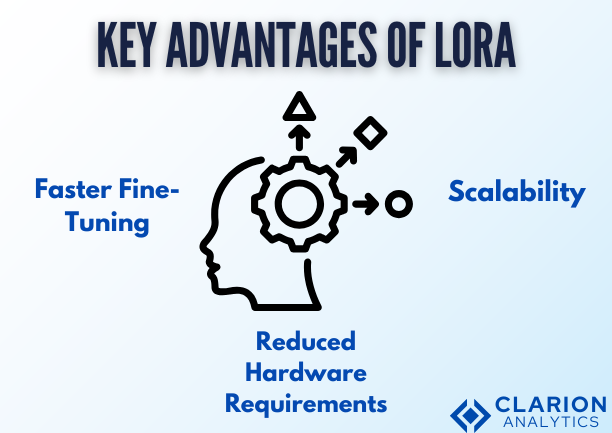
Introduction
- Large Language Models (LLMs) have transformed Natural Language Processing (NLP) applications, driving chatbots, content generation software, and domain-specific AI solutions. Fine-tuning these huge models for a particular task, however, is computationally costly and therefore costly and impractical for most users. Conventional full fine-tuning demands huge GPU memory and extensive training time, making it inaccessible.
- Low-Rank Adaptation (LoRA) is a very efficient fine-tuning method that solves these issues. Rather than fine-tuning all model parameters, it adds low-rank matrices to transformer layers, reducing the training burden considerably without affecting performance. Fine-tuning is even possible on low-end hardware.
- In this article, we shall discuss the basics of LLM fine-tuning, how it works, its usage through Hugging Face’s PEFT library, and practical applications. We shall also refer to optimizations such as QLoRA for additional efficiency.

1. Understanding Fine-Tuning and the Challenges of LLMs
Fine-tuning involves training an already trained LLM for enhancing its ability to deliver specific functions such as medical text summarization or customer service chatbots. The model becomes more precise through training it with data related to a specific domain to make it more relevant.
The process of synchronizing complete model parameters requires extensive GPU memory which makes it impractical for users who possess limited hardware resources.
Computing billions of parameters takes considerable time which results in extended training durations.
The maintenance of numerous finely tuned large model copies needs extensive amounts of disk storage space.
Parameter-Efficient Fine-Tuning (PEFT) Methods
The problem that researchers addressed led to the creation of PEFT methods comprising three different approaches.
Adapters represent smaller neural layers that are attached to frozen pre-trained models.
Prefix-Tuning: Insertion of trainable tokens into input embeddings.
LoRA serves as a compact solution that modifies select weight matrices from transformer layers.
LoRA vs Traditional fine-tuning:
The main difference between full parameter fine-tuning and LoRA emerges through the fact that LoRA works on updating smaller rank decomposed weight matrices rather than touching all parameters like full fine-tuning does. The method evaluates performance and efficiency trade-offs well enough to serve as an effective fine-tuning candidate for LLMs.
2. How Low-Rank Adaptation Works:
Low-rank matrices serve as trainable components of transformer layers while keeping the underlying model parameters unaltered. The method simplifies training because it needs fewer parameters thus speeding up both the memory efficiency of fine-tuning.
The method replaces the complete parameter adjustment by incorporating A and B weight matrices into W base matrix which remain fixed. The new representation becomes:
W` = W + AB
The W matrix is static while both A and B form compact trainable matrices. By implementing this approach the system needs to train fewer parameters and it results in decreased GPU memory requirements.
The system implements low-rank decomposition which transforms large matrices into smaller matrices for approximation. When selecting the appropriate rank value r in LoRA the model maintains its performance quality while accelerating the training process.
Efficiency Gains
By keeping small additional matrices this method reduces the memory usage of VRAM.
The shortened parameter number results in faster training speed.
The fundamental model can use numerous low-rank matrices for different purposes while maintaining the same operational parameters.
3. Implementing LoRA for LLM Fine-Tuning
Hugging Face’s PEFT (Parameter-Efficient Fine-Tuning) library simplifies its integration with transformer models.
Step-by-Step Guide
- Install Dependencies:
pip install transformers peft accelerate bitsandbytes
- Load a Pre-Trained Model and Apply LoRA:
from transformers import AutoModelForCausalLM, AutoTokenizer
from peft import LoraConfig, get_peft_model
model_name = “meta-llama/Llama-2-7b”
tokenizer = AutoTokenizer.from_pretrained(model_name)
model = AutoModelForCausalLM.from_pretrained(model_name)
lora_config = LoraConfig(
r=8, # Rank
lora_alpha=32, # Scaling factor
lora_dropout=0.1,
target_modules=[“q_proj”, “v_proj”]
)
model = get_peft_model(model, lora_config)
- Fine-Tune the Model
from transformers import Trainer, TrainingArguments
training_args = TrainingArguments(
output_dir=”./results”,
num_train_epochs=3,
per_device_train_batch_size=4,
save_strategy=”epoch”,
)
trainer = Trainer(
model=model,
args=training_args,
train_dataset=train_data,
)
trainer.train()
- Key Hyperparameters
- Rank (r): Determines the size of the low-rank matrices (higher values increase expressiveness but require more memory).
- Alpha: Scaling factor that adjusts learning stability.
- Dropout: Helps prevent overfitting by randomly deactivating connections.
4. Benefits, Use Cases, and Future of LoRA
key advantages
The training process becomes more rapid since only small matrices need updating.
Reduced Hardware Requirements: Supports consumer-grade GPUs (such as NVIDIA RTX 3060).
The base model requires no retraining to replace multiple adapters which serve different tasks in the process.
Real-world use cases
Chatbots: fine-tunes LLMs for domain-specific assistants (e.g., healthcare, legal advice).
Multilingual Adaptation: Enables efficient language translation and localization.
Financial Analysis: Customizes LLMs for stock market predictions and risk assessments.
Emergency methods for efficient fine-tuning will define the future of the process.
The memory usage decreases through 4-bit quantization with QLoRA applied to sources from its system.
HLPs act as a combination between various PEFT techniques to optimize overall PEFT efficiency.
Integration with Edge AI: Making LLM fine-tuning viable for low-power devices.
Conclusion
- it presents a game-changing approach to fine-tuning LLMs, balancing efficiency and performance. By reducing memory requirements and training time, it democratizes access to powerful AI models, making them adaptable for various real-world applications. As research advances, techniques like QLoRA will further enhance fine-tuning capabilities, paving the way for more accessible and cost-effective NLP solutions.
- Are you intrigued by the possibilities of AI? Let’s chat! We’d love to answer your questions and show you how AI can transform your industry. Contact Us
